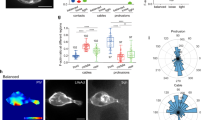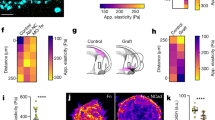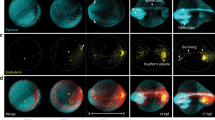Abstract
Although directed migration is a feature of both individual cells and cell groups, guided migration has been studied most extensively for single cells in simple environments1,2. Collective guidance of cell groups remains poorly understood, despite its relevance for development and metastasis3. Neural crest cells and neuronal precursors migrate as loosely organized streams of individual cells4,5, whereas cells of the fish lateral line6,7, Drosophila tracheal tubes and border-cell clusters8 migrate as more coherent groups. Here we use Drosophila border cells to examine how collective guidance is performed. We report that border cells migrate in two phases using distinct mechanisms. Genetic analysis combined with live imaging shows that polarized cell behaviour is critical for the initial phase of migration, whereas dynamic collective behaviour dominates later. PDGF- and VEGF-related receptor and epidermal growth factor receptor act in both phases, but use different effector pathways in each. The myoblast city (Mbc, also known as DOCK180) and engulfment and cell motility (ELMO, also known as Ced-12) pathway is required for the early phase, in which guidance depends on subcellular localization of signalling within a leading cell. During the later phase, mitogen-activated protein kinase and phospholipase Cγ are used redundantly, and we find that the cluster makes use of the difference in signal levels between cells to guide migration. Thus, information processing at the multicellular level is used to guide collective behaviour of a cell group.
This is a preview of subscription content, access via your institution
Access options
Subscribe to this journal
Receive 51 print issues and online access
$199.00 per year
only $3.90 per issue
Buy this article
- Purchase on Springer Link
- Instant access to full article PDF
Prices may be subject to local taxes which are calculated during checkout




Similar content being viewed by others
References
Parent, C. A. & Devreotes, P. N. A cell’s sense of direction. Science 284, 765–770 (1999)
Servant, G. et al. Polarization of chemoattractant receptor signaling during neutrophil chemotaxis. Science 287, 1037–1040 (2000)
Friedl, P., Hegerfeldt, Y. & Tusch, M. Collective cell migration in morphogenesis and cancer. Int. J. Dev. Biol. 48, 441–449 (2004)
Kulesa, P. M. & Fraser, S. E. Neural crest cell dynamics revealed by time-lapse video microscopy of whole embryo chick explant cultures. Dev. Biol. 204, 327–344 (1998)
Lois, C., Garcia-Verdugo, J. M. & Alvarez-Buylla, A. Chain migration of neuronal precursors. Science 271, 978–981 (1996)
Ghysen, A. & Dambly-Chaudiere, C. Development of the zebrafish lateral line. Curr. Opin. Neurobiol. 14, 67–73 (2004)
Haas, P. & Gilmour, D. Chemokine signaling mediates self-organizing tissue migration in the zebrafish lateral line. Dev. Cell 10, 673–680 (2006)
Starz-Gaiano, M. & Montell, D. J. Genes that drive invasion and migration in Drosophila. Curr. Opin. Genet. Dev. 14, 86–91 (2004)
Rørth, P. Initiating and guiding migration: lessons from border cells. Trends Cell Biol. 12, 325–331 (2002)
Duchek, P., Somogyi, K., Jékely, G., Beccari, S. & Rørth, P. Guidance of cell migration by the Drosophila PDGF/VEGF receptor. Cell 107, 17–26 (2001)
Duchek, P. & Rørth, P. Guidance of cell migration by EGF receptor signaling during Drosophila oogenesis. Science 291, 131–133 (2001)
Jekely, G., Sung, H. H., Luque, C. M. & Rorth, P. Regulators of endocytosis maintain localized receptor tyrosine kinase signaling in guided migration. Dev. Cell 9, 197–207 (2005)
Brugnera, E. et al. Unconventional Rac-GEF activity is mediated through the Dock180–ELMO complex. Nature Cell Biol. 4, 574–582 (2002)
Rørth, P., Szabo, K. & Texido, G. The level of C/EBP protein is critical for cell migration during Drosophila oogenesis and is tightly controlled by regulated degradation. Mol. Cell 6, 23–30 (2000)
Bose, R. et al. Phosphoproteomic analysis of Her2/neu signaling and inhibition. Proc. Natl Acad. Sci. USA 103, 9773–9778 (2006)
Luschnig, S., Krauss, J., Bohmann, K., Desjeux, I. & Nüsslein-Volhard, C. The Drosophila SHC adaptor protein is required for signaling by a subset or receptor tyrosine kinases. Mol. Cell 5, 231–241 (2000)
Fulga, T. A. & Rørth, P. Invasive cell migration is initiated by guided growth of long cellular extensions. Nature Cell Biol. 4, 715–719 (2002)
Reichman-Fried, M., Minina, S. & Raz, E. Autonomous modes of behavior in primordial germ cell migration. Dev. Cell 6, 589–596 (2004)
Lloyd, T. E. et al. Hrs regulates endosome membrane invagination and tyrosine kinase receptor signaling in Drosophila. Cell 108, 261–269 (2002)
Pai, L. M., Barcelo, G. & Schupbach, T. D-cbl, a negative regulator of the Egfr pathway, is required for dorsoventral patterning in Drosophila oogenesis. Cell 103, 51–61 (2000)
Yoo, A. S., Bais, C. & Greenwald, I. Crosstalk between the EGFR and LIN-12/Notch pathways in C. elegans vulval development. Science 303, 663–666 (2004)
Ghabrial, A. S. & Krasnow, M. A. Social interactions among epithelial cells during tracheal branching morphogenesis. Nature 441, 746–749 (2006)
Gong, W. J. & Golic, K. G. Ends-out, or replacement, gene targeting in Drosophila. Proc. Natl Acad. Sci. USA 100, 2556–2561 (2003)
Ghiglione, C. et al. The transmembrane molecule Kekkon 1 acts in a feedback loop to negatively regulate the activity of the Drosophila EGF receptor during oogenesis. Cell 96, 847–856 (1999)
Borghese, L. et al. Systematic analysis of the transcriptional switch inducing migration of border cells. Dev. Cell 10, 497–508 (2006)
Zhou, Z., Caron, E., Hartwieg, E., Hall, A. & Horvitz, H. R. The C. elegans PH domain protein CED-12 regulates cytoskeletal reorganization via a Rho/Rac GTPase signaling pathway. Dev. Cell 1, 477–489 (2001)
Rabut, G. & Ellenberg, J. Automatic real-time three-dimensional cell tracking by fluorescence microscopy. J. Microsc. 216, 131–137 (2004)
Acknowledgements
We thank EMBL-ALMF, K. Somogyi and A. M. Voie for help, Y. Cohen and E. Schejter for sharing, and K. Brown, V. Hietakangas, D. Gilmour and S. Cohen for comments. This work was supported by Marie Curie FP6 Intra-European fellowships (A.C. and M.P.), the Academy of Finland and the Helsingin Sanomat Centennial Foundation (M.P.), HFSP (J.M.), EMBO (C.M.L.) and EMBL.
Author Contributions M.P. and A.C. contributed equally to this work and performed all culturing and live imaging experiments. J.M. contributed to the elmo knockout. C.M.L. and T.A.F. performed the protein interaction and genetic analysis of EGFR, respectively. A.B. performed all remaining analyses. P.R. wrote the manuscript.
Author information
Authors and Affiliations
Corresponding author
Ethics declarations
Competing interests
Reprints and permissions information is available at www.nature.com/reprints. The authors declare no competing financial interests.
Supplementary information
Supplementary Information
This file contains Supplementary Figures S1-S5 with Legends, Supplementary Table S1, Supplementary Videos Legends, Supplementary Methods and additional references (PDF 5340 kb)
Supplementary Video 1
This file contains Supplementary Video 1 showing early migration. Early cluster shows elongated morphology with a single cell leading the cluster. Migration is rapid and highly directional (compare to S3). (MOV 5109 kb)
Supplementary Video 2
This file contains Supplementary Video 2 showing early cluster migration followed by shuffling of the cluster. (MOV 5096 kb)
Supplementary Video 3
This file contains Supplementary Video 3 showing later stage of migration (after shuffling phase). Cluster is much rounded thatduring early phase, with less obvious leading cell and more obvious migration by other cells in the cluster. Migration speed is slower that early phase (~0.4µm/min). (MOV 5098 kb)
Supplementary Video 4
This file contains Supplementary Video 4 showing example of cluster shuffling. Cells move and exchange positions often, with little net movement of the cluster. Note that shuffling behaviour generally occurs at junction of posterior most nurse cells. (MOV 5120 kb)
Supplementary Video 5
This file contains Supplementary Video 5 showing dominant negative guidance receptors. Overexpression of DN-PVR and DN-EGFR blocks polarized migration. Cells extend processes but with little net effect. Some backward movement is seen. Genotype: yw,hs-FLP,UAS-CD8-GFP/+; UAS-DN-Egfr, If, slbo1310, / slbo-Gal4, UAS-DN-Pvr (MOV 5111 kb)
Supplementary Video 6
This file contains Supplementary Video 6 showing over-expression of PVF-1 ligand in border cells causes the cluster to adopt a rounded morphology, similar to late phase migration. Cells shuffle, rapidly extend and retract processes and the cluster migrates slowly in the correct direction. Genotype: EPg11235(Pvf1)/+; UAS-CD8-GFP/+; slbo-Gal4/+ (MOV 4117 kb)
Supplementary Video 7
This file contains Supplementary Video 7 showing mid-late migration in control egg chamber.All cells are labeled with nuclear GFP and the relative movement of individual border cell nuclei within the cluster can be appreciated. Genotype: w, hsFLP,sn/+; nos-Gal4-VP16/ ubi-NLS-GFP, FRT40 (MOV 5261 kb)
Supplementary Video 8
This file contains Supplementary Video 8 showing PVF-1 over-expression in germ line. All cells are labeled with nuclear GFP. Overall movement is less severely affected than when PVF1 in expressed in border cells, but despite the early stage the movement is shuffling and slow. Genotype: w,hsFLP,sn/ EPg11235(Pvf1); nos-Gal4- VP16/ ubi-NLS-GFP, FRT40 (MOV 6043 kb)
Supplementary Video 9
This file contains Supplementary Video 9 showing mosaic cluster with PVR overexpression in a single border cell. The c522 driver is used to give mild overexpression of PVR in one outer border cell (as in Figure 4), and also drives GFP expression, which is quite faint. Genotype: y,w,hsFLP,UAS-CD8GFP/ y, w,hsFLP,UAS-CD8GFP; tubGal80,FRT40/ FRT40,42; c522-Gal4/UAS-PVR (MOV 5103 kb)
Supplementary Video 10
This file contains Supplementary Video 10 showing mosaic cluster with 2 hrs mutant cells.Mutant cells marked by GFP expression; one of the hrs mutant cells is bright from the beginning and in the front. Later, a second, faintly positive (mutant) cell is also seen. One hour movie. Genotype: y,w,hsFLP,UAS-CD8GFP/+; tubGal80,FRT40/ HrsD28,FRT40; slbo-Gal4/+. (MOV 3683 kb)
Supplementary Video 11
This file contains Supplementary Video 11 showing mosaic cluster with 2 elmo mutant cells.Mutant cells marked by GFP expression. Second phase of migration, including tumbling in which front position alternates between elmo mutant and control (GFP negative) cells. Genotype: y,w,hsFLP,UASCD8GFP/+;tubGal80,FRT40/ elmoKO,FRT40;slbo-Gal4/+. In early phases (other movies), elmo mutant cells usually stayed in the rear. (MOV 3153 kb)
Rights and permissions
About this article
Cite this article
Bianco, A., Poukkula, M., Cliffe, A. et al. Two distinct modes of guidance signalling during collective migration of border cells. Nature 448, 362–365 (2007). https://doi.org/10.1038/nature05965
Received:
Accepted:
Issue Date:
DOI: https://doi.org/10.1038/nature05965
This article is cited by
-
Transcriptome analysis reveals temporally regulated genetic networks during Drosophila border cell collective migration
BMC Genomics (2023)
-
Effect of substrate stiffness on friction in collective cell migration
Scientific Reports (2022)
-
Live imaging of delamination in Drosophila shows epithelial cell motility and invasiveness are independently regulated
Scientific Reports (2022)
-
Two Rac1 pools integrate the direction and coordination of collective cell migration
Nature Communications (2022)
-
To lead or to herd: optimal strategies for 3D collective migration of cell clusters
Biomechanics and Modeling in Mechanobiology (2020)
Comments
By submitting a comment you agree to abide by our Terms and Community Guidelines. If you find something abusive or that does not comply with our terms or guidelines please flag it as inappropriate.



